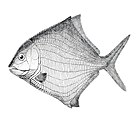Chondrostei is a group of non-neopterygian ray-finned fish. While the term originally referred to the paraphyletic grouping of all non-neopterygian ray-finned fish, it was redefined by Patterson in 1982 to be a clade comprising the Acipenseriformes and their extinct relatives.
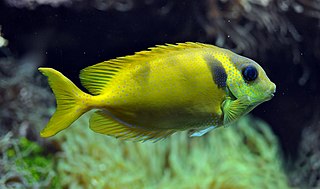
Neopterygii is a subclass of ray-finned fish (Actinopterygii). Neopterygii includes the Holostei and the Teleostei, of which the latter comprise the vast majority of extant fishes, and over half of all living vertebrate species. While living holosteans include only freshwater taxa, teleosts are diverse in both freshwater and marine environments. Many new species of teleosts are scientifically described each year.

Xenacanthus is a genus of prehistoric xenacanths. Fossils of various species have been found worldwide.

Holostei is a group of ray-finned bony fish. It is divided into two major clades, the Halecomorphi, represented by the single living genus, Amia with two species, the bowfins, as well as the Ginglymodi, the sole living representatives being the gars (Lepisosteidae), represented by seven living species in two genera. The earliest members of the clade, which are putative "semionotiforms" such as Acentrophorus and Archaeolepidotus, are known from the Middle to Late Permian and are among the earliest known neopterygians.

The Palaeonisciformes, commonly known as "palaeoniscoids" are an extinct grouping of primitive ray-finned fish (Actinopterygii), spanning from the Silurian/Devonian to the Cretaceous. They are generally considered paraphyletic, but their exact relationships to living ray-finned fish are uncertain. While some and perhaps most palaeoniscoids likely belong to the stem-group of Actinopteryii, it has been suggested that some may belong to the crown group, with some of these possibly related to Cladistia and/or Chondrostei. Many palaeoniscoids share a conservative body shape and a similar arrangement of skull bones.

Birgeria is a genus of carnivorous marine ray-finned fish from the Triassic period. Birgeria had a global distribution, with fossil known from Madagascar, Spitsbergen, Germany, Switzerland, Italy, Slovenia, China, Russia, Canada and Nevada, United States. The oldest fossils are from Griesbachian aged beds of the Wordie Creek Formation of East Greenland. Birgeria existed throughout the entire Triassic period, from the very beginning just after the Permian-Triassic mass extinction, up to the very end with its extinction during the Triassic-Jurassic mass extinction.
Aulopopsis is an extinct genus of prehistoric marine ray-finned fish that lived during the lower Eocene. It is considered a relative of lizardfish in the order Aulopiformes, but its exact taxonomic placement is uncertain. Some authorities place it with the Aulopidae, while others place it with the Giganturoidae.

Ainia is an extinct genus of prehistoric ray-finned fish that lived during the Kimmeridgian stage of the Late Jurassic epoch. It contains a single species, A. armata, known from the famous Solnhofen Limestone of Germany. It is a distant relative of the bowfin, although it is more closely related to genera such as Caturus and Osteorachis.

Paracentrophorus is an extinct genus of prehistoric ray-finned fish that lived during the Induan age of the Early Triassic epoch in what is now Madagascar. The type species is Paracentrophorus madagascariensis (monotypy).

Besania is an extinct genus of prehistoric marine ray-finned fish that lived during the Anisian and Ladinian ages of the Middle Triassic epoch in what is now southern/southeastern Switzerland and northern Italy. Fossils were recovered from the Besano Formation of Monte San Giorgio area and the Prosanto Formation of canton Graubünden, Switzerland.
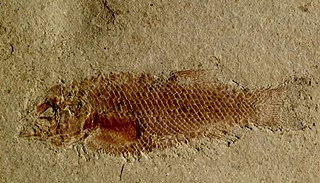
Acentrophorus is an extinct genus of prehistoric freshwater and marine ray-finned fish from the Roadian to the Wuchiapingian of England, Germany (Kupferschiefer), Italy and Russia. There may also be a Triassic occurrence in Australia.

Aetheretmon is an extinct genus of prehistoric freshwater and estuarine ray-finned fish that lived during the early Mississippian (Dinantian) age in what is now Europe, including Scotland, Belarus, and Russia. It contains only the species A. valentiacum. This genus has the oldest known actinopterygian growth series, indicating that juvenile Aetheretmon had tails similar to those of modern teleosts, but unlike teleosts, their upper tails continued to grow throughout their lives instead of truncating early. Initially classified as a "palaeoniscid", later studies have recovered it as a stem-neopterygian, or more recently a stem-actinopteran.

Bobasatrania is an extinct genus of prehistoric bony fish that survived the Permian-Triassic extinction event. Fossils of Bobasatrania were found in beds of Changhsingian to Ladinian age. It was most speciose during the Early Triassic.

Dipteronotus is an extinct genus of stem-neopterygian ray-finned fish that existed during the Middle and Late Triassic epochs in what is now Europe and Morocco. As a typical feature, it had several ridge scales in front of its dorsal fin that created a spine-like structure.

Sargodon is an extinct genus of neopterygian ray-finned fish that lived during the Middle and Late Triassic epochs in what is now Europe.
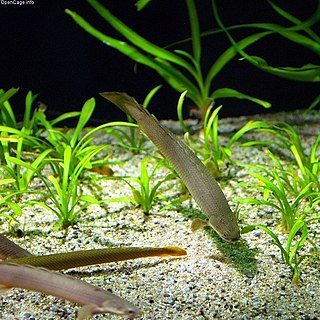
Cladistia is a clade of bony fishes whose only living members are the bichirs of tropical Africa. Their major synapomorphies are a heterocercal tail in which the dorsal fin has independent rays, and a posteriorly elongated parasphenoid.

Ptycholepiformes are an extinct order of prehistoric ray-finned fish that existed during the Triassic period and the Early Jurassic epoch. The order includes the genera Acrorhabdus, Ardoreosomus, Boreosomus, Chungkingichthys, Ptycholepis, and Yuchoulepis. Although several families have been proposed, some studies place all these genera in the same family, Ptycholepididae.

Bobasatraniiformes is an extinct order of durophagous ray-finned fish that existed from the late Permian to the Middle Triassic in both marine and freshwater environments. The order includes two families: Bobasatraniidae, with the genera Bobasatrania, Ebenaqua, and Ecrinesomus, and Dorypteridae, comprising only the genus Dorypterus (monotypy). Bobasatraniiformes had a somewhat global distribution; fossils are found in Africa (Madagascar), Asia (Pakistan), Australia, Europe, and North America.
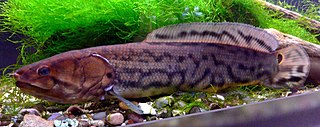
Amia, commonly called bowfin, is a genus of bony fish related to gars in the infraclass Holostei. They are regarded as taxonomic relicts, being the sole surviving species of the order Amiiformes, which dates from the Jurassic to the Eocene, persisting to the present. There are two living species in Amia, Amia calva and Amia ocellicauda, and a number of extinct species which have been described from the fossil record.

Sam Giles is a palaeobiologist at the University of Birmingham. Her research combines modern imaging with fossils to understand the evolution of life, in particular that of early fish, and in 2015 "rewrote" the vertebrate family tree. She was a 2017 L'Oréal-UNESCO Rising Star and won the 2019 Geological Society of London Lyell Fund.
























